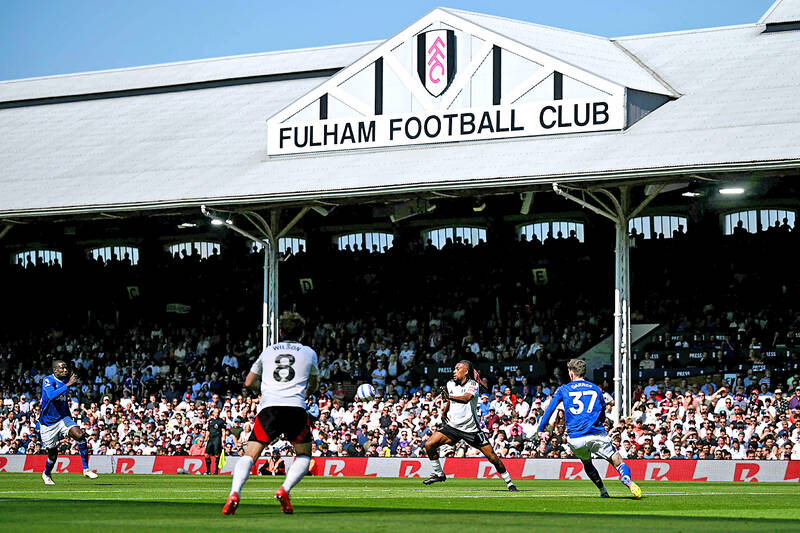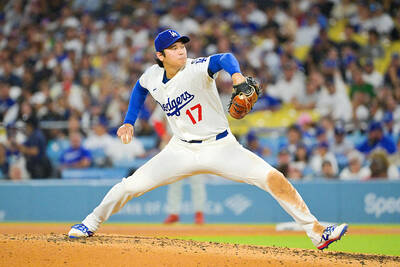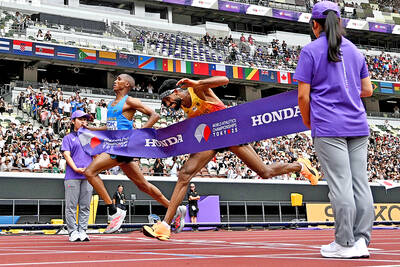The English Premier League has become a place where not just the other half reside, but the 1 percent. If money follows money, then England’s top tier is a place to be seen, to do business, to entertain and for those who can afford the corporate facilities, which are increasingly important to soccer’s bottom line.
On Saturday, before Fulham’s 3-1 loss against Everton, the club hosted its grand opening of the Riverside Stand. Its exoskeleton was a feature of the River Thames during the COVID-19 pandemic.
Behind the project is Shad Khan, Fulham’s Pakistani-American billionaire owner. “Shad put the vision on steroids,” Fulham chief executive officer Alistair Mackintosh said.

Photo: AFP
The project has cost significantly more than its initial pricing of £100 million (US$133 million), with officials and architects tight-lipped about the overall cost on launch day.
“A location like no other, a real gamechanger for Fulham Football Club, our neighborhood and all of London,” Khan said as construction began in 2019.
The architect Populous worked on the Tottenham Hotspur Stadium and the All-England Club.
Fulham aim to offer the highest-end, most elite corporate facility in soccer.
Hospitality customers would be charged from £3,000 to £20,000 a season over nine tiers, with individual match packages on sale. Plus value-added tax.
Not for the faint of wallet, at a club where fans have been protesting against prices, saying not all Fulham fans can afford West London house prices. The club retains a suburban working-class core of support, despite an outwardly genteel image.
“The decision to implement a modest increase was made with careful consideration,” the club said on May 1 as 2.8 percent season-ticket increases were levied.
Craven Cottage has become a place of contrasts. Opposite the Riverside’s architectural modernity is the Johnny Haynes Stand, a surviving creation of Archibald Leitch, the Scottish architect whose art deco designs were used at Anfield, Old Trafford, Hampden Park and White Hart Lane, among others. Most of those grand designs have passed into history.
Leitch’s continued influence is obvious in the Riverside Stand’s five tiers, as is that of Thames boathouses.
This section of London’s main river conjures images of Oxford-Cambridge Boat Races, Ringo Starr’s caper with a young scruff during a Hard Day’s Night and romcom scenes from Sliding Doors.
Fulham seek to reimagine the Cottage as more than a soccer ground.
“A venue for everyone, every day of the year,” Mackintosh said.
On non-matchdays, southwest London’s joggers can run along the Thames Path, under the new stand’s decks.
Wembley’s arches and Stamford Bridge are visible from the decking. On the opposite bank, Barnes Football Club, an important marker of soccer’s development in the late 19th century.
Soccer is not necessarily central to the project. The Thames is the star attraction, not the playing field. Lighthouse Social is a membership scheme for non-matchdays, with about 600 members added so far. With a local committee, styled as a neighborhood-friendly scheme, it has a selection process that might be associated with central London’s private members’ clubs.
Mention of Fulham FC within the new development is minimal, although a small club badge is visible on the walkway to Khan’s presidential seat.
A grand piano is ordered for the third-tier Sky Deck to make it resemble the ballroom of the Titanic in a facility designed by a Parisian outfit whose trade is high-end restaurants and hotels.
The scallops, sea bream and Veuve Clicquot menu contrasts with pile ’em high soccer clubs filling punters’ bellies with pies and pints of beer.
An Agatha Christie chic is added by the fourth tier’s slim corridors resembling the Orient Express, a world away from sticky-carpet concourses in other Premier League clubs’ corporate facilities, the Gallic type of art-deco, almost nautical setting, lifelong Cottager Hugh Grant might be found acting out a period drama.
The Riverside looked glorious on a late-spring day, although the Cottage can be one of soccer’s chilliest settings when wintry winds whip from the river.
As yet, the rooftop swimming pool that has made headlines is unfinished. The promise is that it would be heated.

San Francisco Giants pitcher Teng Kai-wei impressed against the Arizona Diamondbacks on Monday despite an 8-1 loss in the opener of the team’s nine-game road trip. Teng, the only Taiwanese pitcher active in MLB, struck out five while allowing two hits and one walk over four innings at Chase Field to finish with a no decision, as the teams were tied 1-1 when he finished his outing. He surrendered the lone run of his outing in the bottom of the first, which began with a walk, a hit-by-pitch and two strikeouts. Diamondbacks leadoff hitter Geraldo Perdomo advanced to third on

New Zealand yesterday basked in “amazing” athletics glory after winning two gold medals in as many days at the World Athletics Championships in Tokyo. Geordie Beamish on Monday claimed New Zealand’s first track gold in history with a shock victory in the 3,000m steeplechase, while high jumper Hamish Kerr followed with gold on Tuesday to make it an unprecedented double success for a country much better known for rugby than its prowess in track and field. Before this week, the country had won only six golds in total at the championships. Yesterday morning New Zealand were in the giddy position of fourth on

After Shohei Ohtani on Tuesday pitched five hitless innings for the Los Angeles Dodgers, the Philadelphia Phillies’ Rafael Marchon hit a tiebreaking, three-run homer off Blake Treinen with two outs in the ninth inning for a 9-6 win. Brandon Marsh had a two-run homer and Max Kepler added a solo shot in a six-run sixth for Philadelphia. Ohtani’s 50th homer leading off the eighth helped the Dodgers tie the game 6-6. The Phillies erased a 4-0 deficit against Justin Wrobleski in another stunning collapse by the Dodgers bullpen. Philadelphia rallied for four runs in the seventh and eighth innings and another in the

PHOTO FINISH: The finish was closer than at the 2001 championships in Canada, when Ethiopian Gezahegne Abera edged Kenyan Simon Biwott by a single second Alphonce Felix Simbu yesterday snatched gold in the first photo finish at a major championship marathon, edging out German Amanal Petros in a dramatic race to the line to give Tanzania its maiden world title. The photo finish showed the 42.195km race was decided by three hundredths of a second as Simbu surged past the diving Petros at the line, closer than the 0.05-second gap between the gold and silver medalists in the men’s 100m final on Sunday. Simbu and Petros were given the same time of 2 hours, 9 minutes and 48 seconds, the German taking the silver despite